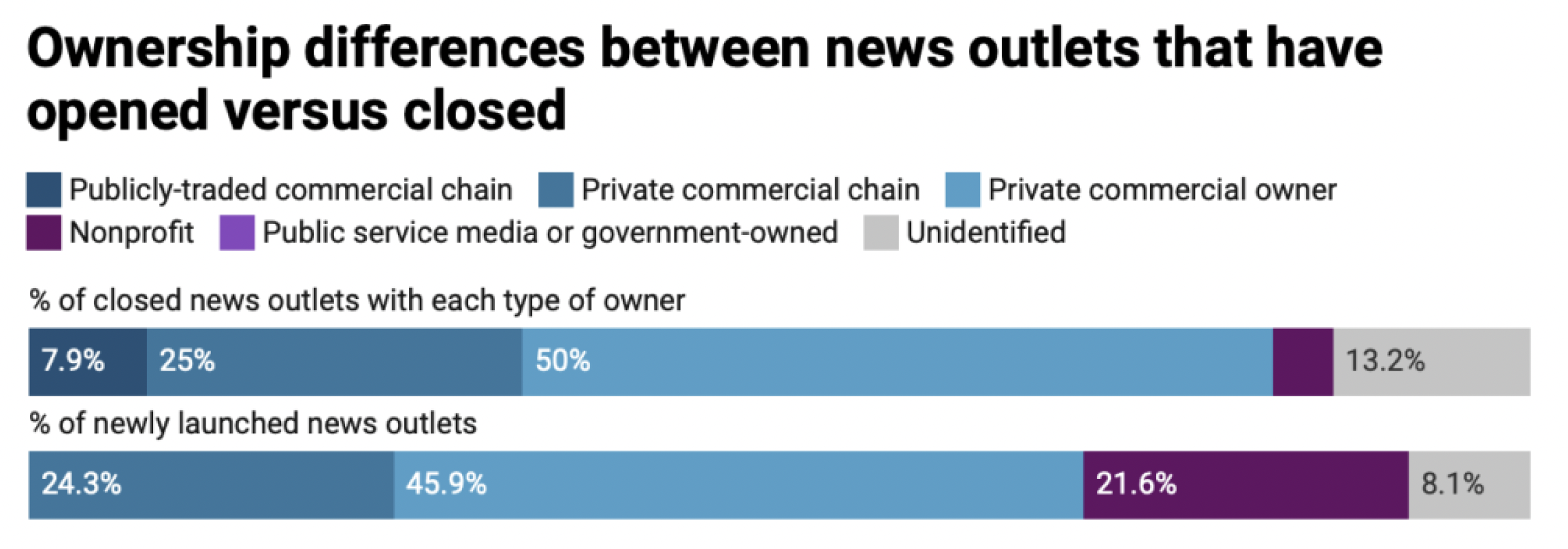The next chapter for local news in Minnesota depends upon what those working both within and outside of the ecosystem choose to do with this information.
Local News Impact Consortium
Research Publications
Minnesota’s Local News Ecosystem Report 2024
Monitoring the health of Minnesota’s local news landscape through studying the supply of local outlets.
Benjamin Toff | Director, Minnesota Journalism Center | September 27, 2024
The full report and map are available at https://newsmap.umn.edu/.
What does a healthy ecosystem for local news look like?
We know that relative to other states, Minnesota has a great number of strengths and assets, benefiting from some of the highest newspaper subscription rates and levels of civic engagement in the country.
On the supply side, Minnesota also has some of the most active and vibrant institutions reporting and producing local news: a regional newspaper whose owner has invested in digital innovation and a statewide expansion in its coverage; a large and influential public media broadcaster that serves communities throughout Minnesota, which has also helped to incubate new initiatives geared toward underserved communities.
From MinnPost to Project Optimist to Documenters, the state also has a large and growing number of nonprofit news outlets and is home to one of the first and most active Press Forward Locals in the country—a broad philanthropic effort that seeks to mobilize funders around support for local news.
In short, Minnesota is poised to be a model for what’s possible for a local news ecosystem in 2024.
And yet, Minnesota is far from immune to the same challenging dynamics impacting the industry nationally and globally.
In the last several years, there have been an alarming series of stories about newspaper closures all around the state, and we know there are many places that go without access to local news of any relevance or substance to their communities at all.
This report is the most comprehensive, systematic effort to date to take stock of what the local news ecosystem looks like in Minnesota in 2024. We have sought to identify where each and every source of local news and information exists statewide across modes of media (print, radio, television, and digital), and to some extent even beyond the boundaries of conventional journalism.
We have undertaken these efforts in order to establish a benchmark that can be used to compare changes over time.
Should we see improvements in the coming years as more communities invest in local news, we hope to be able to establish how these newly launched outlets have helped to counteract or at least stem the tide of recent declines.
The report also highlights where new investments in local news are already being made both by commercial owners as well as new nonprofit initiatives, which account for a small but growing minority of this sector. By examining the role played by ownership and ownership changes in the disappearance of news outlets statewide, the report underscores the need for continued monitoring of these aspects of media organizations’ stewardship by policymakers, community members, and others who care about the future of local journalism in their communities.
5 Key Findings
- More than 12 percent of all local news outlets in Minnesota have closed since 2018, a pace of more than 11 per year. Over the last six years, we tracked 76 closures out of 602 news outlets identified. Closures have occurred almost exclusively among print newspapers and to a lesser extent digital enterprises with broadcasters a relative source of stability across the ecosystem.
- For every two news outlets that closed, there has been one new local news outlet launched during this same period. Thirty-eight newspapers and digital sites have helped to replace some of what has been lost since 2018 with many of the new outlets situated in the same communities where closures have occurred.
- Places served by news outlets tend to be whiter and older than places without any news outlets specifically serving them. The demographic profile of places in Minnesota with news outlets serving them are also somewhat less educated and less wealthy, a reflection of the large number of small legacy newspapers that continue to serve smaller towns and communities in Greater Minnesota. Likewise, there are few differences in the demographic profile of the places where outlets have closed compared to where they have launched.
- Ownership changes may be a critical sign that closures are looming. We estimate, conservatively, that 11 percent of the ecosystem experienced a change in ownership in the last decade and that among those that did, nearly 30 percent ended up closing in the years that followed. One way to stem the tide of closures may be for communities and policymakers to pay closer attention to changes in ownership to prevent closures before they take effect.
- Nonprofit news has grown significantly as a share of the local news ecosystem. While commercial owners account for the vast majority of news outlets in the ecosystem, nonprofits were behind more than one-in-five of the new outlets founded since 2018.

Graphic: Ownership differences between news outlets that have opened verses closed.
In Conclusion
Each part of the ecosystem is shaped by forces that extend far beyond the borders of Minnesota, especially economic headwinds that so often constrain decision-making in newsrooms and influence the willingness of entrepreneurs to take chances on new journalistic enterprises.
The indicators systematically gathered as part of this study offer one way of understanding the outcomes of these processes, but they do not tell a complete story nor do they predict the future.
The next chapter for local news in Minnesota depends upon what those working both within and outside of the ecosystem choose to do with this information.

About the Author
Benjamin Toff
Share and Share Alike
At the LNIC, one of our primary objectives is to share information and research that supports the health and growth of local news ecosystems. We encourage you to share our research with others and invite your feedback, questions, and insights about our ongoing work.
Get Involved
Whether you’re a researcher, community advocate, or supporter of journalism, the LNIC invites you to join our mission. By contributing to our growth, participating in working groups, or engaging with the tools we’re building, you can help ensure local communities have access to trustworthy news and information.
The Latest from the LNIC
LNIC featured in News @ Knight
The Local News Impact Consortium aims to make local news landscape studies more efficient and less costly. This new academic collaboration aims to use automation, common standards to make future research more accessible to industry professionals and communities.



